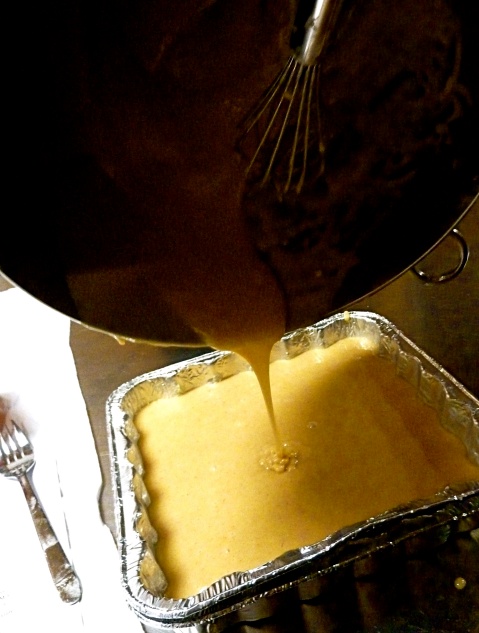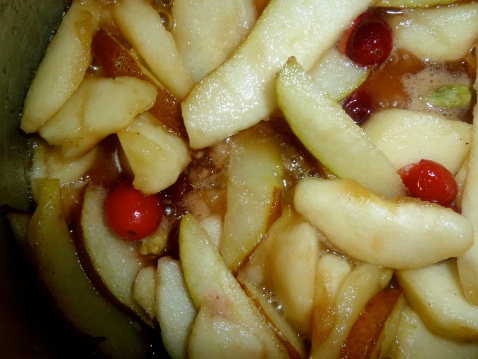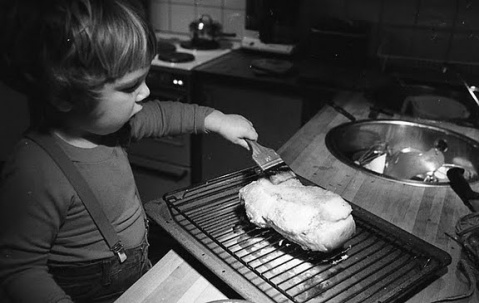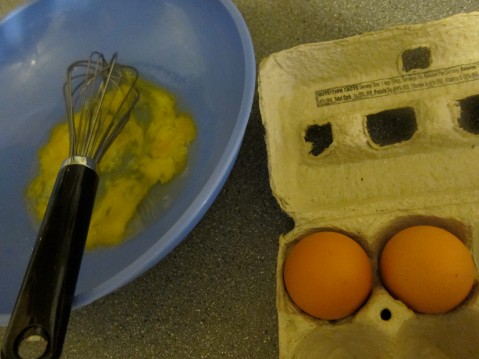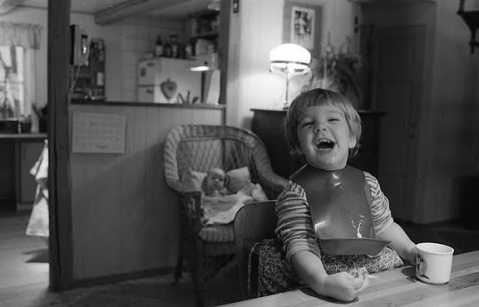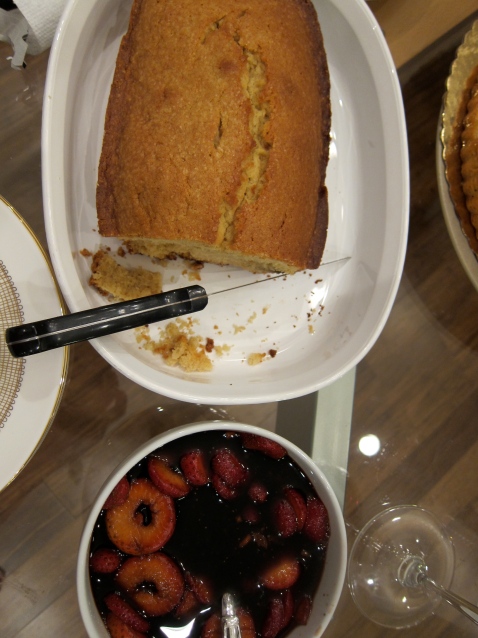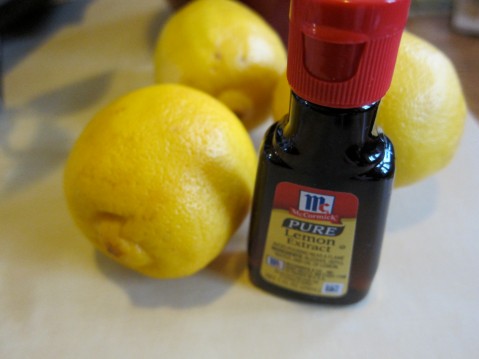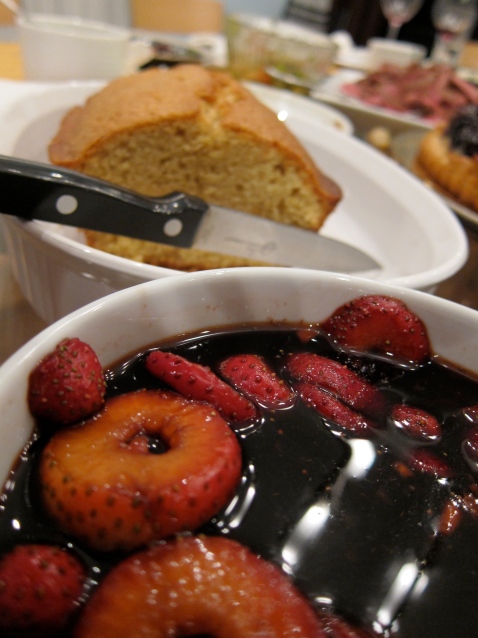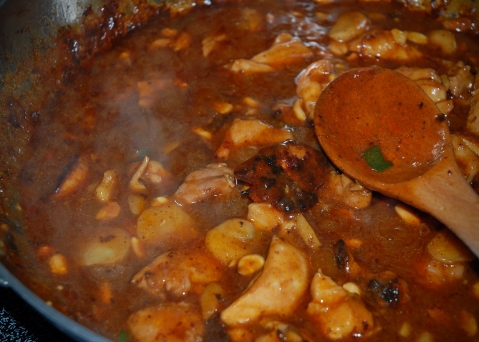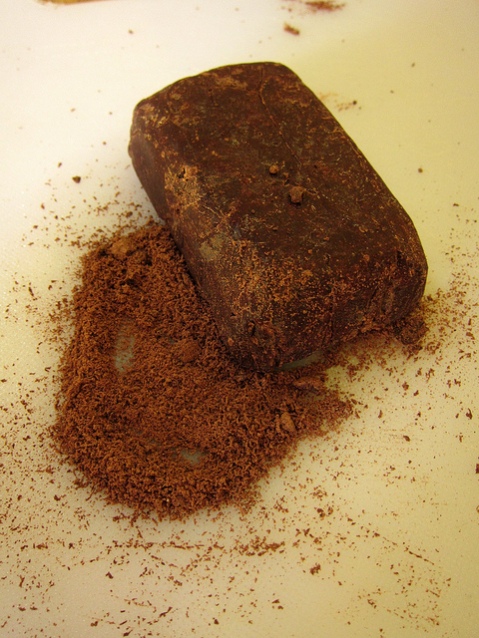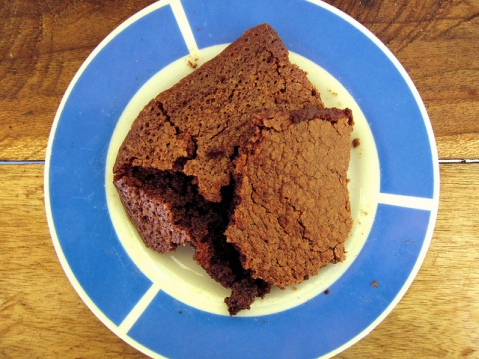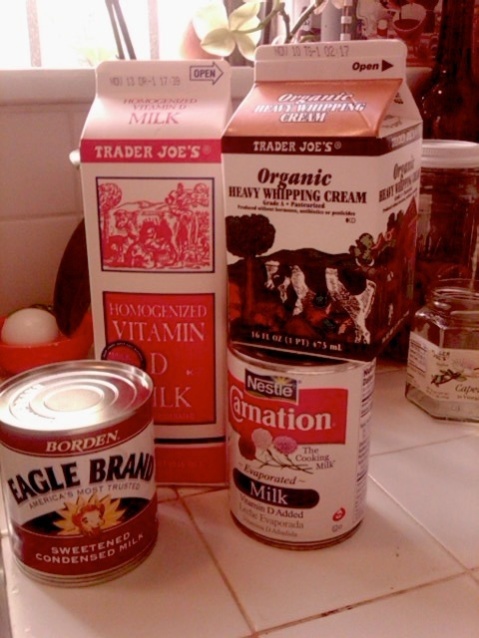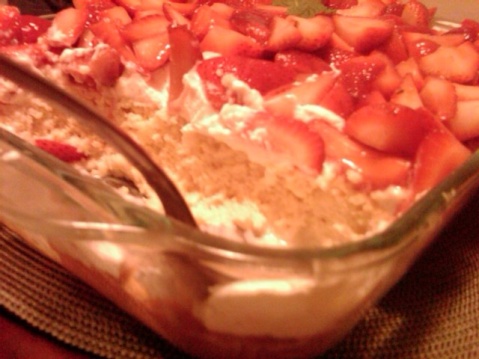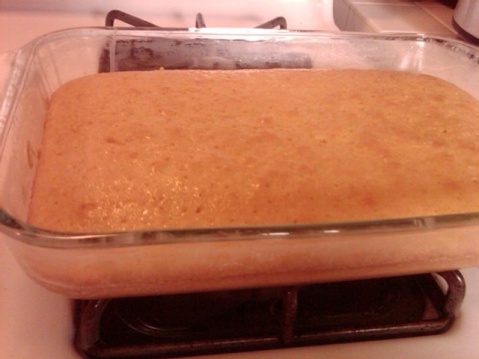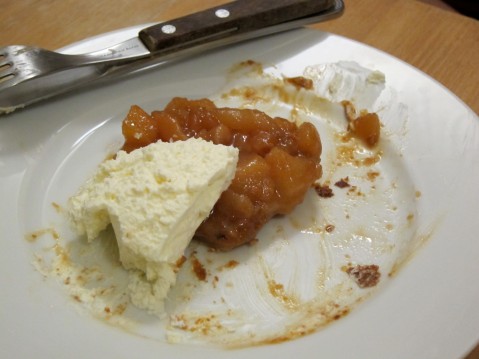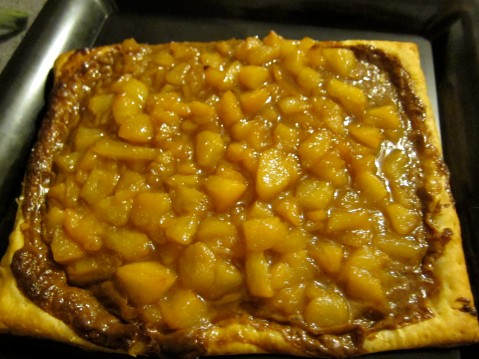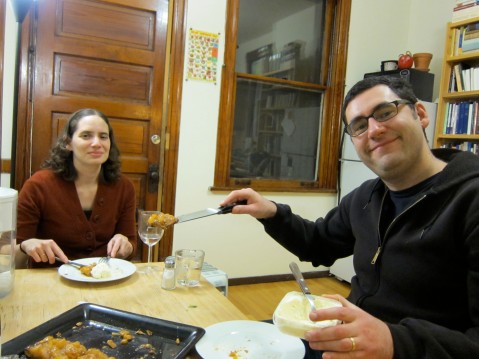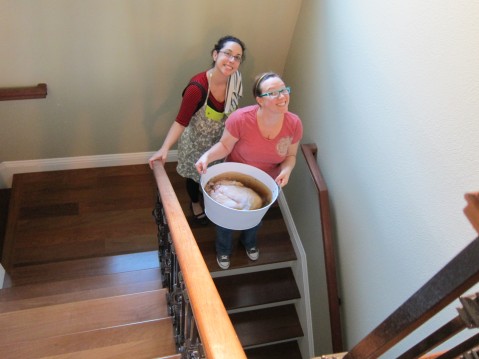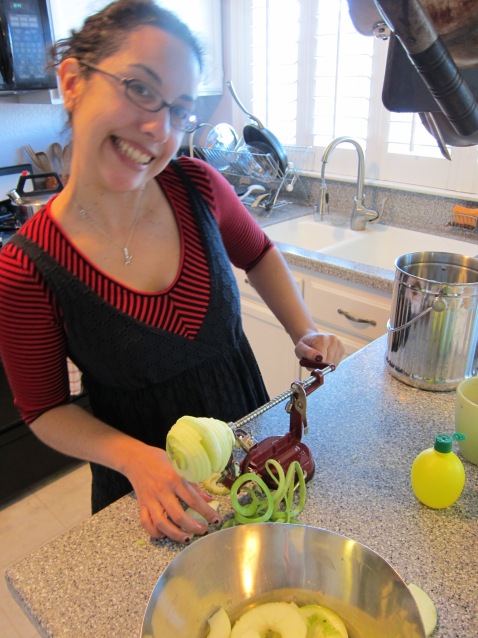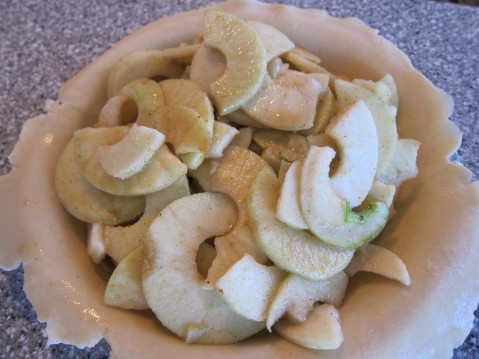Guest Blogger: Krissy’s Honey Chai-Spice Cake with Caramelized Autumn Fruits
The lovely Krissy is a globe-trotting India-phile, who has spent several summers in the Tamil-speaking region of the country. She wants to share with you some tricks she’s picked up on her adventures there.
Krissy:
Everything I cook (or eat) lately is somehow inspired by my food experiences in Tamil Nadu, South India, where I lived the past two summers. Whenever I grab a Starbucks latte while rushing to class, I fondly think back to lazing around in the afternoon heat drinking ten-cent “kapi,” which achieves a similar frothy-top effect sans espresso machine by pouring steaming hot milk coffee back and forth—the higher the better (here’s proof!)—between a stainless-steel tumbler and bowl. And whenever I sit down with a plate and fork, I think of the small “mess” restaurants where I’d be served unlimited piles of rice and vegetables on a banana leaf and eat it with my hands. What to do when it’s 40 degrees, blustery, and the grocery stores are filled with pumpkins and squash?
As I was deciding what to bake tonight, I surveyed my meager stock of baking ingredients, which happens to be rather disproportionately represented by Indian options. My eyes fell upon three things in particular: a jar of raw honey that has been absolutely begging to be used up, chai spice (from Milwaukee’s The Spice House, which is certainly worth a visit if you’re ever in that part of the Midwest), and a bunch of cardamom pods (move over, nutmeg!!). I’d never heard of honey cake before, but this recipe I found seemed promising and extremely versatile, so I decided to heat it up with my two Indian ingredients: chai spice and cardamom. The subtle kick of cardamom added a perfect balance to a topping of caramelized autumn fruit, and the chai spice added much-needed diversity to the lonely cinnamon that was carrying the weight of this cake. The cake itself ends up having a pleasant chewy almost caramel-like surface and a moist interior. Since Thanksgiving has just passed, I went for a topping of the autumn classics: caramelized apples, pears, and some cranberries, and I’d highly recommend “cooling it off” with vanilla ice cream! (And maybe pairing it with apple cider?) But I’d imagine you could put any spin on it that you wanted, depending on the season or your mood. Bunches of oats, perhaps?
Honey Chai-Spice Cake
adapted from Martha Stewart’s Honey Cake with Caramelized Pears
Unsalted butter, softened, for pan
1 3/4 c. all-purpose flour, plus more for dusting
3/4 tsp. baking powder
1/2 tsp. baking soda
a pinch coarse salt
1/2 tsp. ground cinnamon
1/4 tsp. chai spice
2 large eggs
1/2 c. granulated sugar
1/4 c. packed light-brown sugar
1/2 c. plus 2 tablespoons best-quality honey
1/2 c. milk
1/2 c. vegetable oil
Carmelized Autumn Fruits (recipe to follow)
Freshly whipped cream, or ice cream for serving (optional)
Preheat oven to 325 degrees. Butter an 8×8 inch baking pan. Dust with flour; tap out excess. Whisk together the flour, baking powder and soda, salt, cinnamon, and chai spice in a bowl; set aside. Mix eggs and sugars until pale and thick, about 3 minutes.
Whisk together honey, milk, and oil. (For this, I needed to melt down my raw honey.) With mixer on low, add honey mixture to egg mixture; mix until combined, about 1 minute. Add half the flour mixture; mix until smooth. Mix in remaining flour mixture. Pour batter into pan. (The batter may be thinner than you are used to—never fear! It should bake up just right.)
Bake until dark golden brown and a cake tester inserted in center comes out clean, about 50 minutes. Let cool in pan 15 minutes. Run a thin knife around edge of cake; carefully remove sides of pan. Transfer cake to a platter. Top with fruit. Serve with whipped cream or ice cream.
Caramelized Autumn Fruits
1 tbsp. unsalted butter
1/4 c. sugar (white or brown)
1 3/4 lbs. red Anjou pears/Apples cut into 1/2-inch-thick wedges (or 1/4-inch-thick wedges if firm)
Handful cranberries (for color)
1/4 c. best-quality honey
2 green cardamom pods
a few dashes chai spice
Heat butter in a large skillet over medium heat. Add sugar, cardamom pods, and chai spice; cook, stirring, until almost dissolved, 1 to 2 minutes. (A note about cardamom pods: often in Indian cooking, you let flavors “seep” into a liquid and you let that liquid flavor the dish. This, as far as I can tell, is what “tempering” means, e.g. adding tempering oil to chutneys. And similarly with Indian sweets, cardamom pods are often thrown whole into the milk to infuse it with a light flavor—this is the method I used here. If you would like a more intense cardamom flavor, you can break the pods open and add the seeds or buy powdered cardamom and add a few pinches.) Add fruit; cook, stirring occasionally, until soft and just golden, 12 to 20 minutes. Pour in honey; cook, stirring, until fruit is coated and very soft, 3 to 5 minutes. Remove the cardamom pods before serving.
Lemon Pound Cake with Balsamic-Marinated Strawberries
Traditionally, pound cake is made with a pound of butter, a pound of sugar, a pound of eggs, and a pound of flour. Essentially that’s four pounds of crazy. Who can eat all that? This version is much more manageable: loaf size. It’s not a cake of the super moist variety, but has a consistency more like a breakfast bread. As such, it holds up beautifully to the marinated strawberries. The balance of zingy and sweet here is delightful. Balsamic and strawberries are a genius combination that I was introduced to by Kat Santore many moons ago. Thanks, Kat!
Lemon Pound Cake with Balsamic-Marinated Strawberries
Strawberries
1 lb. strawberries, rinsed, hulled, and sliced
juice of 1 lemon
1/2 c. balsamic vinegar
1/4 c. sugar.
Combine all ingredients well and let sit in the fridge while you make the pound cake. The longer, the better. With a slotted spoon, spoon the strawberries on top of each slice of cake to serve.
Lemon Pound Cake
1/2 c. light brown sugar
1/2 c. white granulated sugar
2 sticks butter
4 eggs
1 tsp. lemon extract
1 tbsp. lemon zest
1 3/4 c. all-purpose flour
1/2 tsp. baking powder
2/4 tsp. salt
Preheat oven to 350.
Grease and flour a loaf pan.
In a large bowl, beat sugar and butter until fluffy. Beat in eggs, one at a time. Add lemon extract and zest.
In a separate bowl, combine flour, baking, powder, and salt. Gradually add to the sugar mixture.
Pour batter into the prepared pan. Bake for an hour, or until a toothpick inserted into the center comes out clean.
Bourbon-Pecan Oatmeal Cookies
Sometimes I feel like an audience member for Emeril Live: when a recipe calls for liquor or gahlic, I can’t help but cheer wildly.
Which is why I chose this recipe: bourbon. Gorgeous, warm, coat-your-bones bourbon. Firey intestines. Front porch, rocking chair. Sunny afternoons. I feel the same way about sunshine as I do about bourbon; that is, I approve of them both mightily. And today was a doozy of a sunny day. Naomi and I took an after-lunch walk to Washington Park, found a pond, and tried to identify the delicate-blue pelt covering the new green grass (bluebells). The sun is still a bit crisp, but generous.
Combined with the roasted pecans and the bourbon vanilla I used, these cookies have a lovely front-porch, sunny-day flair.
Bourbon Pecan Oatmeal Cookies
from Bakewise by Shirley O. Corriher
2 c. pecans
1/2 c. plus 2 tbsp. unsalted butter, divided
1 tsp. salt
2 c. old-fashioned or quick-cooking oats
1/4 c. shortening
1 c. light brown sugar, packed
1 tbsp. pure vanilla extract
2 tbsp. bourbon (the best part)
2 tbsp. heavy cream
1 large egg
1 1/4 c. all-purpose flour
1 tsp. baking soda
1 tsp. ground cinnamon
1/2 tsp. freshly grated nutmeg
nonstick cooking spray
parchment paper
Preheat oven to 350 degrees.
Spread the pecans on a baking sheet and roast for 10 minutes. While they are hot, transfer to a bowl and stir in 2 tbsp. of butter and sprinkle with 1/4 tsp. of salt. When cool, coarsely chop and set aside.
Process the oats in a food processor with the steel blade for about 10 seconds.
With a mixer, beat the remaining 1/2 c. butter, shortening, and sugar until light and fluffy. Beat in the vanilla, bourbon, and cream. Add the egg and beat just to blend.
In a mixing bowl, stir together the flour, baking soda, 3/4 tsp. salt, cinnamon, and nutmeg. On the lowest speed, add flour mixture into butter mixture in several portions. Stir in the oats and pecans by hand.
Cover a baking sheet with parchment paper sprayed with nonstick cooking spray. Drop by heaping tablespoons onto the baking sheet. Bake one sheet at a time for about 10 minutes, until puffy and lightly browned on the edges. Move to a cooling rack.
Mocha Custard
Hello chocolate. Hello creamy shot of seratonin to my brain. Custards, mousses (meese?), puddings–anything creamy and rich sends me into hog heaven. This recipe is no exception. Jen passed it along to me after raving about it, and she adapted from the good ol’ Better Homes and Gardens Cookbook.
I made it to go with my chipotle tacos. It was a lovely accompaniment, as well as a nod to the long history of cacao in Mexico (documented as far back as 1100 BC, with the word deriving from Nahuatl).
It made a whole lot of custard–or perhaps my ramekins are especially small for this recipe. Either way, equip yourself for a hearty dose of luscious milky mocha.
Mocha Custard
Adapted from Better Homes and Gardens Cookbook, via Jen (the Soupista)
Makes 6
Custard
2 1/4 c. milk
1/3 c. sugar
3 tbsp. unsweetened cocoa powder
2 tbsp. instant coffee
1/4 tsp. cinnamon
3 eggs, whisked
1 1/2 tsp. vanilla
Topping: Bailey’s + Heavy whipping cream, whole coffee beans
Preheat oven to 325.
Heat milk, sugar, cocoa, coffee and cinnamon, stirring until just dissolved. Pour into mixing bowl with eggs and vanilla (preferably bowl with pour spout). Beat for a few minutes.
Put 6 custard cups (or ramekins or coffee cups) into a deep baking dish. Divide mixture among cups. Pour boiling water around cups to depth of 1 inch. Bake for 45 minutes to an hour, or until a knife inserted in the middle comes out clean.
Cool on wire rack. Cover and chill at least 2 hours before serving (will keep for about 24 hours). Garnish with cream whipped with baileys and whole coffee beans.
Kung Pao Feast and Fortune Cookies
Siggy and Sara and I used to go to Big Bowl in Gold Coast a lot when Siggy lived there, and Siggy would order Kung Pao Chicken EVERY SINGLE TIME. So, when I found the recipe in a cookbook called Spices of Life, I knew I’d have to make it for her. And what better time than her birthday? A few weeks ago, we got together at Sara’s and had a feast. Angela made fortune cookies and Sizchuan green beans and Sara made a tofu version of the kung pao (using the same ingredients as those called for in the chicken marinade, and soaking the tofu overnight). What a spread!
Wikipedia tells me that it was politically incorrect until the 1980s to refer to this dish as Kung Pao in China, as it’s named after Ding Baozhen, a Qing Dynasty official (“kung pao” is derived from his title as palace guardian), who fell out of favor during the Cultural Revolution. In China, they call this dish fast-fried-chicken-cubes (hong bao ji ding). So, please enjoy these delicious fast fried chicken cubes, which are much easier to make than I’d thought. Or, as Angela put it: A delightful East meets West concoction, devoid of hatred and full of home-cooked energies.
Kung Pao Chicken (or Tofu)
from Nina Simonds’s Spices of LIfe
1 1/2 lb. boneless, skinless chicken meat (I used thighs)
(or extra firm tofu)
marinade
2 tbsp. soy sauce
2 tbsp. rice wine or sake
1 tsp. toasted sesame oil
1 tsp. cornstarch
4 1/2 tbsp. olive oil
seasonings
2 tbsp. minced scallions
1 1/2 tbsp. minced fresh ginger
1 1/2 tbsp. minced garlic
1 tsp. hot chile paste or dried chile flakes, to taste
1 1/2 c. thinly sliced water chestnuts, about 8 oz.
sauce
1/2 c. chicken broth or water
2 1/2 tbsp. soy sauce
2 tbsp. rice wine or sake
1 tsp. toasted sesame oil
1 tbsp. Chinese black vinegar or Worcestershire sauce
1 1/4 tsp. cornstarch
1 c. diced scallion greens
1 1/2 c. unsalted dry-roasted peanuts
Trim the chicken of any fat or gristle and cut into 1/2-inch cubes. Place in a bowl. Add the marinade and toss lightly to coat. Cover with plastic wrap and refrigerate for 20 minutes.
Heat a wok or a skillet, add 2 1/2 tbsp. of oil, heat until very hot, and add the chicken. Cook over high heat until the chicken becomes opaque and is cooked, about 3 to 4 minutes. Remove with a strainer and drain. Wipe out the pan.
Add the remaining oil and heat until hot. Add the seasonings and stir-fry briefly, about 15 seconds, then add the water chestnuts and stir-fry over high heat for about 1 1/2 minutes to heat through. Add the sauce and cook, stirring continuously to prevent lumps, until thickened. Return the cooked chicken to the pan and add the scallion greens and the peanuts. Toss lightly to coat and heat through. Serve with steamed rice.
Spicy Sichuan-Style Green Beans
from Nina Simmonds’s Spices of Life
2 1/2 lb. green beans, rinsed and drained
2 1/2 tbsp. olive oil
seasoning
1 1/2 tbsp. minced scallions, white part only
2 tbsp. minced garlic
1 tsp. hot chile paste or dried chile flakes
sauce
3/4 c. chicken broth
3 tbsp. soy sauce
2 1/2 tbsp. rice wine or sake
1 1/2 tbsp. sugar
1 tsp. toasted sesame oil
2 tsp. Chinese black vinegar or Worcestershire sauce
1 1/4 tsp. cornstarch
1/2 c. toasted sliced almonds for garnish
Trim the ends of the beans and cut the beans into 3-inch lenths.
Bring water to a boil in a medium pot. Add the green beans adn bring to a boil again. Reduce the heat to medium and cook uncovered for about 8 minutes, or until almost cooked but still crisp. Drain in a colander and refresh in cold water. Drain again.
Heat a wok or a deep skillet, add the oil and heat until hot. Add the seasonings. Stir-fry briefly, about 15 seconds, then add the sauce. Bring to a boil, stirring continuously to prevent lumps, until thickened. Return the cooked green beans to the pan, toss lightly to coat, and scoop onto a serving platter. Sprinkle with the toasted almonds.
Fortune Cookies…from Angela:
In keeping with the Chinese food-themed celebration of our dear Sigela, I offered to make fortune cookies. While I have many strengths (yelling imaginative profanities; delivering swift justice; dancing poorly), baking is not one of them and I was afraid I had bitten off more than I could chew (another one of my strengths). Nevertheless, I found this recipe very easy to put together, and after my first trial batch, I’d like to think I could medal in The North American Fortune Cookie Folding Finals. But practice makes perfect! I highly recommend making a trial batch before you go for the gold.
Fortune Cookies
From Martha Stewart (http://www.marthastewart.com/recipe/fortune-cookies)
5 tbsp. unsalted butter
4 large egg whites
1 c. superfine sugar
1 c. all-purpose flour, sifted
Pinch of salt
3 tbsp. heavy cream
1 tsp. almond extract
Nonstick cooking spray
Heat oven to 400 degrees. Spray a cookie sheet liberally with cooking spray (Note: For my first batch I made sure to spray the cookie sheet, but found that it was more wasteful than anything. There’s enough butter in here that your cookies shouldn’t stick if you’re using a non-stick sheet). Melt butter in a small saucepan over low heat; set aside.
In the bowl of an electric mixer (Note: I blended everything by hand and it came out just fine.) combine egg whites and sugar, and beat on medium speed, about 30 seconds. Add flour and salt, and beat until combined. Add butter, heavy cream, and almond extract, and beat until combined, about 30 seconds.
Using a regular teaspoon, spoon a glob of batter onto one half of the baking sheet, and spread with the back of the spoon into a thin 5-inch circle; repeat on the other half of the sheet. (The tricky part is ensuring that the batter is spread evenly enough.) Bake until the edges of the cookies turn golden brown. Martha suggests 8 minutes, but I found that 6 minutes was plenty of time in the oven.
Transfer baking sheet to a heat-resistant surface. Working as quickly as possible, slide a spatula under the cookies and place on a clean kitchen towel. Using your fingers, fold the cookie in half, pinching the top together to form a loose semicircle. Hold the cookie with your index fingers inserted at each open end, and slide your thumbs together along the bottom line. Press into the center of the cookie while bending the two open ends together and down to form the shape of a fortune cookie. This whole process should take about 10 seconds. Once the cookie hardens, which begins to happen almost immediately, you cannot fold it. Place the fortune cookie on the kitchen towel to cool, and shape the second cookie. Repeat until all the batter is used up. To speed up the process, bake four cookies at a time, staggering two cookie sheets by 4 minutes to give you time to shape. To avoid wasting batter, practice folding with a circle of paper first.
Write your message on a long strip of sturdy art paper. If you’re hardcore, you can place a strip of paper in the center of the cookie after you’ve baked it but before you fold it, but really I just rolled up a strip of paper and tucked it inside one of it’s cone-y halves.
Stay tuned! I intend to create a vegan version very soon…
Juliette’s Best Cocoa Brownies
My lovely friend Juliette has been living in Panama for the past three years, first as a Peace Corps volunteer, and now as a new mom to a gorgeous Panamanian-Californian baby named Adrian. A few years ago, I was lucky enough to go visit her in her idyllic, green village–a remote community that requires an hour and a half hike to reach (no road).
She’s now living in town, so hiking boots and a horse are no longer required to visit her.
When I was there, she made me hot chocolate directly from a cacao pod, with a bit of milk and sugar. It was the most concentrated chocolateness I’d ever experienced–bitter, rich, coating my tongue. Needless to say, Juliette does not take chocolate lightly. Her trick for amazing brownies is all in the cocoa. Her notes below:
I would recommend leaving out up to a 1/2 cup of sugar for those bakers who prefer brownies with more emphasis on the chocolate than on the sugar. I followed the recipe exactly and they almost tasted like fudge because they were so sweet, though the texture was absolutely perfect. The chocolate I used was 100% cacao from a farmer in Bocas del Toro. Cacao producers working with Peace Corps volunteers can always make a bit of money selling chocolate to all of the PC folks throughout the country. Needless to say, it’s in high demand! This last batch of cacao I bought has notes of cinnamon, so the brownies came out with the same flavor– pretty delish! The recipe is below. I got it off of Epicurious.com, but I believe the original recipe is from Bon Appetit.
Best Cocoa Brownies
from epicurious.com
10 tbsp. (1 1/4 sticks) unsalted butter
1 1/4 c. sugar
3/4 c. plus 2 tbsp. unsweetened cocoa powder (natural or Dutch-process)
1/4 tsp. salt
1/2 tsp. pure vanilla extract
2 cold large eggs
1/2 c. all-purpose flour
2/3 c. walnut or pecan pieces (optional)
Special equipment: An 8-inch square baking pan
Position a rack in the lower third of the oven and preheat the oven to 325°F.
Line the bottom and sides of the baking pan with parchment paper or foil, leaving an overhang on two opposite sides.
Combine the butter, sugar, cocoa, and salt in a medium heatproof bowl and set the bowl in a wide skillet of barely simmering water. Stir from time to time until the butter is melted and the mixture is smooth and hot enough that you want to remove your finger fairly quickly after dipping it in to test.
Remove the bowl from the skillet and set aside briefly until the mixture is only warm, not hot. Stir in the vanilla with a wooden spoon. Add the eggs one at a time, stirring vigorously after each one. When the batter looks thick, shiny, and well blended, add the flour and stir until you cannot see it any longer, then beat vigorously for 40 strokes with the wooden spoon or a rubber spatula. Stir in the nuts, if using.
Spread evenly in the lined pan. Bake until a toothpick plunged into the center emerges slightly moist with batter, 20 to 25 minutes. Let cool completely on a rack. Lift up the ends of the parchment or foil liner, and transfer the brownies to a cutting board. Cut into 16 or 25 squares.
Chocolate note: Any unsweetened natural or Dutch-process cocoa powder works well here. Natural cocoa produces brownies with more flavor complexity and lots of tart, fruity notes. I think it’s more exciting. Dutch-process cocoa results in a darker brownie with a mellower, old-fashioned chocolate pudding flavor, pleasantly reminiscent of childhood.
(Guest Blogger) The Baketrix: Tres Leches Cake
Pauline, today’s lovely guest columnist, is teasing me with this amazing-sounding cake. Pauline, please FedEx this to Chicago. Better yet, come visit and make this for me.
The Baketrix:
My friend and new mommy Sarah Cifarelli (as of Dec 2010) made this amazing Tres Leches Cake for a potluck dinner with the Gurls. It was so delicious. Now, I truly enjoy desserts, but usually tres leches cakes are so dense and sickening sweet, I can only eat a small piece. Well, Sarah’s recipe is rich in flavor yet light in texture. Instead of weighing me or my plate down, I was truly uplifted by it. I had a huge, and I mean HUGE, slice!!!!
Tres Leches Cake Recipe
serves 12 or less depending on how big you make the servings!!!
1/2 c. butter (1 stick) melted and cooled, plus more for greasing the baking dish
1 1/2 c. all-purpose flour
1 tsp. baking powder
1/2 tsp. coarse salt
5 large eggs
1 c. sugar
1 tsp. pure vanilla extract
1 can (14oz) sweetened condensed milk
1 can (12 oz) evaporated milk
1 c. whole milk
2 c. heavy cream
5 c. fresh fruit, optional, such as oranges or berries, for serving
Preheat oven to 350 degrees.
Lightly butter a 9×12-inch baking dish. (Note: if using a metal pan, keep an eye out on the cake as it will be done in less time.)
In medium bowl, whisk together flour, baking powder, and salt.
In a large bowl, using an electric mixer, beat egs and 3/4 c. sugar on high until pale and thick, about 4 minutes. Add vanilla and beat to combine. With mixer on low, gradually add flour mixture and beat to combine. With a rubber spatula, fold in melted buttah until incorporated. Transfer batter to dish and back until top is golden brown, about 30 to 35 minutes.
In a medium bowl, whisk together milks. Poke warm cake ALL over with a wooden skewer or toothpick, then pour milk mixture over the top and let it cool to room temperature, about 1 hour. The cool part is watching the milks get absorbed into the cake – like magic!
Whip cream and 1/4 c sugar to medium peak, add to the cake and add fruits and eat up!!!!
Pear and Dulce de Leche Tart
Good morning, and a good new year to you. I’ve eaten my lucky new-year black-eyed peas (thanks, Garen), and I am feeling optimistic for the year of lucky number 11. I was listening to this song this morning, and have declared it the perrrrrrrrfect anthem to start the year:
After such a sucky 2010, I think most all of us could use a little luck. Or at least a little feeling good. What better thing to eat in a lucky new year than a luscious pear and dulce de leche tart? New year diet? Bah! It has fruit, so it’s not all that bad for you. And besides, I’m a believer in eating well enough all year and not cramming it in to some guilt-packed resolution. Diet be damned. Eat some of this.
To start the year with a little inspiration, I’m reading Julia Child’s My Life in France (thanks, Melissa), and I love, love, love her exuberance. I know she had a memorable, infectious personality in real life, and it comes forth completely on the page. Here’s to a new year with even a fraction of her vigor.
I made this tart to accompany a borscht dinner by Josh and Rachel back in December. I almost went with chocolate ganache instead of dulce de leche, but I saw the can in the supermarket and I couldn’t resist. Is there anything better? Sweet, sweet, creamy goodness. I whipped up some heavy cream with sugar and vanilla for a delicious topping. It’s easy to make and, really, what doesn’t taste good on top of puff pastry?
I’m in the mood to feed people, so come on over.
Pear and Dulce de Leche Tart
6 to 7 pears, peeled and chopped into 1/4″ chunks
juice and zest of 1 lemon
2 to 3 c. apple cider
2 tsp. ground ginger
2 cinnamon sticks
1 sheet of puff pastry
3 to 4 tbsp. dulce de leche
Preheat oven to 350 degrees. Bring puff pastry out of the freezer to thaw, about 10 minutes.
In a pan over medium heat, combine pears, lemon juice & zest, cider, ginger, and cinnamon. Reduce until it becomes a thick compote. Set aside.
Spread dulce de leche in a nice, thick layer on the puff pastry. Spread the pear compote on top of that. Bake for about 20 minutes, until the pastry is brown and toasty and cooked through.
Happy Thanksgiving! And Pie.
As onions saute in the kitchen and Tami sings along to Frosty the Snowman, I sit staring out a window that frames palm and cypress trees, layers of houses built into rising hills. I just got back from the beach. I’m south of San Francisco in a small coastal town aptly called Pacifica, with gloriously mild, sunny weather–not to mention babies, cats, friends, and delicious smells. I am thankful.
Christine and I went to a farmer’s market yesterday and then for an afternoon glass of wine at a small wine bar. Something about the way of interacting with the strangers we met, the casual California manner, made me so distinctly nostalgic for it. I am a Californian and can live anywhere, and can love many places, but something here connects to my synapses in a very visceral way. Doesn’t hurt that I’m surrounded by great people and sunshine and the ocean.
I think the thing I’m most thankful for is just capacity. The fact that I continue to be able to feel passionate about places and ideas, that I have so much love in my life. And that it doesn’t sort of ever reach its bottom.
We spent all day yesterday cooking, especially attending to the pie portion of the meal. Tami is a pie maven. She is known far and wide for these pies she makes, so naturally she lined up four for us to make for this extravagant meal. I’ve asked her to blog about them. And I’ve dubbed her the Pie-lette, for both her pie skills and her organizational (though not necessarily geographical) navigatory skills. Please note that, though she likes to make these pies, she does not like to eat pies. I dunno. Ask her.
The Pie-Lette:
Kate asked that I guest blog about my pie. Not a girl to turn down talking about my pie (nor to pass on an enjoyable double entendre), I naturally agreed. In anticipation of that great gluttonous celebration that is the giving of thanks, I baked four pies. For a dinner that will be attended by, at most, 6 adults and 2 toddlers. Most people view this as a very favorable pie:person ratio, made even more so by the fact that while I adore (baking) pie, I do not enjoy (eating) pie (usually).
My pie strategy is intricate. I spend months before gratitude-day reading about, and then test-baking pies. The menu is determined not as much by the size of the crowd (though certainly to an extent by the guests’ personal tastes and favorites), but by the success of my experiments. This year’s menu, the culmination of months of hard work and research, includes the following offerings: (1) Pumpkin Pie (x2, because we needed some pie after thinking about pie all day and could not possibly wait one whole other day for the consumption of pie), (2) Apple Pie (because people like apple pie), and (3) Pear Tart (because if anything is more fun than eating pie it’s eating a tart!)
The plan was to make first the apple pie, then the pumpkin, and finally the tart. But crust debacles intervened, and the tart decided to debut first. Hers is a simple crust, in a butter-rubbed dish, with pear halves dusted with cinnamon sugar on top. She’s lovely, and tasty, and an obviously rich addition to a day centered on giving thanks.
Pressed Pear Tart
from Real Simple
1/2 c. (1 stick) unsalted butter, plus more for the pan, at room temperature
1 c. all-purpose flour, plus more for your fingers
1/4 tsp. baking powder
1/2 c. sugar, plus 1 1/2 tablespoons
1 large egg
2 to 3 Bosc pears, peeled, halved, and cored
1 1/2 tsp. ground cinnamon
1/4 c. apricot jam
1 tbsp. fresh lemon juice
whipped cream (optional)
Directions
Heat oven to 350° F.
Butter a 14-inch rectangular tart pan and set aside.
Combine the flour and baking powder in a medium bowl and set aside.
Using an electric mixer, cream the butter and 1/2 cup sugar at high speed in a large bowl. Lower speed to medium, add the egg, and beat until incorporated. Gradually add the flour mixture until fully incorporated. The dough will be very soft.
Push the dough into the pan with floured fingers to form an even crust. Arrange the pear halves, top to bottom, cut-side down. Sprinkle with the cinnamon and the remaining sugar. Bake until the crust is golden brown, about 45 minutes; let cool.
Heat the apricot jam and lemon juice in a small saucepan over medium-low heat, mixing until combined. Remove from heat and brush gently over the entire tart. Serve with the whipped cream, if desired.
**** The Pie-Lette’s Apple Pie:
Next came the apple pie – a classic, deviation-free, retelling of Mark Bittman’s recipe. Being not in general a fan of pie (in this context), I especially abhor fruit pies. To me, they are like jello sandwiches. On Wonderbread. But, as with most food I cook, I bake apple pie to please others (most especially my father, an apple pie true believer). And this recipe, I have come to discover through years of reuse, is well-loved. I note also that this pie permitted us to introduce Kate to the apple corer-slicer-peeler that is pleasant on functional as well as aesthetic levels. She was appropriately enthusiastic.
¼ c. brown sugar
¼ c. white sugar, or more if you would like a very sweet pie, plus a little for the top of the pie
½ tsp. ground cinnamon
1/8 tsp. fresh grated nutmeg [I use jarred nutmeg, being obviously not as awesome as Mark Bittman]
Pinch salt
5 or 6 Cortland, McIntosh, or other good cooking applies [we used 4 large Granny Smith]
1 tsp. freshly squeezed lemon juice [I squeezed mine straight from the plastic lemon in my fridge; don’t tell]
1 ½ tsp. cornstarch or 2 tablespoons instant tapioca (optional) [I view tapioca flour as essential, and cornstarch unthinkable]
2 pie crusts
2 tbsp. unsalted butter, cut into bits
Milk as needed
Toss together the sugars, spices, and salt. Peel and core the apples and cut them into ½- to ¾-inch-thick slices. Toss the apples and lemon juice with the dry ingredients, adding the cornstarch or tapioca if you want a less runny pie.
Pile the apples into the rolled-out bottom crust, making the pile a little higher in the center than at the sides. Dot with butter. Cover with the top crust. Decorate the edges with a fork or your fingers. Refrigerate while you preheat the oven to 450 degrees Fahrenheit.
Place the pie on a cookie sheet and brush the top lightly with milk; sprinkle with sugar. Use a sharp paring knife to cut two or three 2-inch-long vent holes in the top crust; this will allow steam to escape. Place in the oven and bake for 10 minutes. Reduce the heat to 350 degrees Fahrenheit and bake for another 40 or 50 minutes, or until the pie is golden brown. Do not underbake. Cool on a rack before serving warm or at room temperature.
***Pumpkin Pie
And finally, after a turkey brining and cranberry relish crafting interlude, it was time to bake the pumpkin pie. Pumpkin pie is not an optional pie when it comes to Thanksgiving. It is the only sort of pie (well, not the only but among the few varietals) I am willing to eat. Again, I stick to tried and true Mark Bittman, though I have test-baked my way through dozens of recipes to determine that his is the best. I have used canned pumpkin and fresh, frozen crusts and scratch baked, all manner of spices and milks, and the below recipe provides the best spicy, sassy flavor and smooth, luscious texture. Mmmmmmpie.
Pie Crust
3 eggs
¾ c. sugar
½ tsp. ground cinnamon
1/8 tsp. freshly grated nutmeg [again, I used jarred nutmeg because we cannot all be Mr. Bittman]
½ tsp. ground ginger [which I omit as I am not a ginger fan]
Pinch ground cloves
Pinch salt
2 c. canned or fresh pumpkin puree or cooked [I used canned this time; I find the texture preferable to fresh]
2 c. half-and-half, light cream, or whole milk [I have tried all, and prefer half-and-half]
Prebake the crust [at 425 degrees Fahrenheit, for about 10 minutes or as long as it takes to finish the rest of the filling preparation.] When the crust is done, turn the oven down to 375 degrees Fahrenheit.
Beat the eggs with the sugar, then add the spices and salt. Stir in the pumpkin puree and then the half-and-half. While the crust is baking, warm this mixture in a medium saucepan over medium-low heat, stirring occasionally, until it is hot to the touch; do not boil.
Place the pie plate on a baking sheet. Pour this mixture into the still-hot crust and bake 30 to 40 minutes, until the mixture shakes like Jell-O but is still quite moist. Cool on a rack and serve warm or at room temperature.

